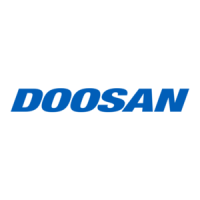
Do you have a question about the Doosan DP180L Series and is the answer not in the manual?
Details procedures for starting and safely stopping the engine.
Outlines the technical specifications and performance data for the engine models.
Describes routine inspections performed by the operator before engine operation for safety.
Provides a table outlining inspection and replacement intervals for various engine components.
Lists tightening torque values for main parts and general bolts.
Provides a step-by-step procedure for disassembling the engine.
Details the procedure for reassembling the engine, including attaching various components.
Details the general information and adjustment procedures for the fuel injection pump.
Lists symptoms, causes, and troubleshooting for intake/exhaust system issues like noise, vibration, and lowered output.
Illustrates the electrical wiring connections for the engine system.
Provides general information, specifications, views, and wiring for the starter motor.
Covers general information, views, wiring diagrams, specifications, and performance of the alternator.
Details performance specifications like speed range, droop, and stability for the speed controller.
Covers Starting Fuel, Speed Ramping, Idle, Gain, Stability, Speed, Overspeed, and Droop rpm.
Procedures for checking and adjusting engine stability and speed after starting.
Provides a four-step voltage test to diagnose system failures.
Details tests for engine overspeeding, manual speed maintenance, and actuator issues.
Guides on setting starting fuel, RPM ramping, and idle speed for optimal engine start.
Details I/O type and terminal functions for Actuator, Pick-Up, Battery, Speed Trim, Droop, Idle, AUX, and 10V Output.
Guides on connecting battery, pick-up sensor, and actuator to the controller.
Explains actuator connection to the controller and engine cylinder.
Guides on connecting the pick-up sensor to terminals C and D, including gap adjustment.
Illustrates connections for operation information, RS232, and CAN communication.
Allows users to input Kp, Ki, and Kd values for PID control.
Offers automatic designation of P, I, and D parameters for engine PID control.
Displays fault codes, descriptions, and output for troubleshooting.
Guides on setting the engine's overspeed protection RPM.
Guides on setting the amount of fuel for engine start to minimize smoke.
Details how to configure PID gain parameters (Kp, Ki, Kd).
Explains how to perform automatic PID tuning for engine control.
Provides guidance on reviewing the alarm list for system faults and their measures.
Details procedures for checking battery voltage, input resistance, and power LED for system diagnosis.